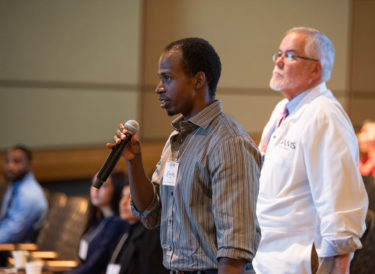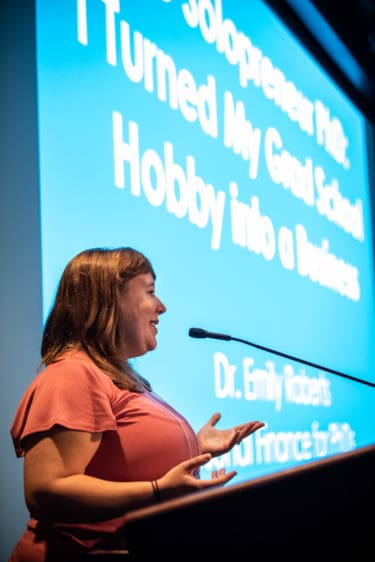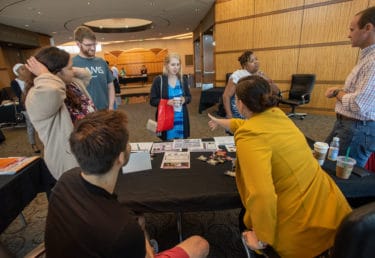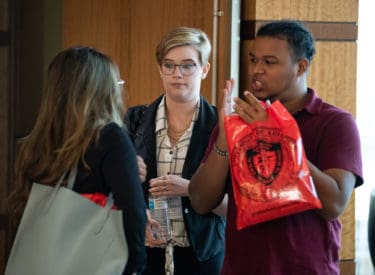Students Explore Biomedical Sciences Options at Career Day
| A graduate degree in biomedical science serves as preparation for many different careers, but how do students decide which one might be the right fit?
The 19th annual Career Day for Biomedical Sciences gave graduate and undergraduate students a chance to think about just that, and to hear about the different types of careers directly from people in those fields.
“When you get an advanced degree today, the opportunities for you are so much broader than ever before,” said Dana Gaddy, Ph.D., a professor in the Department of Veterinary Integrative Biosciences in the College of Veterinary Medicine at Texas A&M University and former faculty member at UAMS. “The landscape is ever-changing. So your job today as you’re sitting here looking at each of these positions is to ask yourself: What resonates with you? What sounds like your cup of tea?”
Gaddy was one of the speakers representing academic biomedical science, long considered the standard career path for graduating Ph.D. students. Not so anymore, Gaddy said. Students go on to a variety of fields, and even the life of an academic scientist is varied.
Other speakers talked about transitioning from bench research to a postdoctoral talent recruiter, pursuing public health in the laboratory setting, owning a scientific business, harnessing a biomedical engineering career from Alaska to Arkansas, and combining clinical and research work.
For example, Gaddy spent a large portion of her career at UAMS in endocrinology and then physiology. She studied reproductive endocrinology, specifically the hypothalamic pituitary gonadal axis, and worked on osteoporosis and growth factors. Now in the veterinary school at Texas A&M, she is working on a large animal model for hypophosphatasia, a rare bone disease in humans. Starting over in a new lab in a new area of study was intense, but just the kind of thing for Gaddy, who likes to be constantly challenged and experience new things.

Career Day was set up so that it was easy for students to ask questions and mingle with the speakers.Bryan Clifton
“It’s been a blast and a really wild ride, and I have more fun than anybody does, and I’d do it all again just the same,” she said.
Biomedical academic scientists wear a lot of hats, Gaddy said: research, teaching, mentorship and service to the profession. Because of this, academic scientists must continually learn, hone a variety of skills, stay curious, and keep up with their constantly changing field. They need to enjoy interacting with students and be thrilled by the idea of forging their own path, even if that comes with the stress of writing grants and managing lab finances and personnel.
“People depend on you for their jobs, and that’s the kind of thing that keeps you up at night,” Gaddy said.Gaddy also showed a graph to represent her career. Once you get past the truly challenging work of establishing a career, successes start to “snowball,” she said, but at every step of the way, there are ups and downs. Grants get rejected. Students go on to great things. Lines of research don’t pan out. Others lead to cures.
“You have to be able to deal with rejection,” Gaddy said. “But the highs — they are really good, and they make it worth the low points. And the highs aren’t just getting grants accepted. I think when I stand here today and look back on my career, the biggest highs were seeing my students succeed. That’s the cool part.”UAMS Graduate School Dean Robert E. McGehee Jr., Ph.D., encouraged the students to ask questions, network with speakers and booth representatives and make the most of the time.
“At the end of the day, one of the most important resources all of us have is time, whether you’re a high school student or a grizzled old faculty member like me,” McGehee said. “These folks have taken a day out of their lives to come and share their perspectives with you. And that’s because they’re committed to your success. They are wholly committed to the notion of paying it forward. So the last thing you should do is be afraid to ask them a question.”The speakers were:
- “From Manchester to Memphis: My Path from Research to Recruitment” — Linda Harris, Ph.D., Director of Postdoctoral Talent Acquisition, St. Jude Children’s Research Hospital, Academic Programs in Biomedical Sciences
- “Public Health Laboratory Careers” — Katie Seely, Ph.D., Section Director, Environmental Laboratories, Arkansas Department of Health
- “The Solopreneur PhD: I Turned My Grad School Hobby into a Business” — Emily Roberts, Ph.D., Owner, Personal Finance for PhDs, Seattle, Washington
- “A Scientist’s Career in Academia: How Many Colorful Hats Can You Wear” — Dana Gaddy, Ph.D., Professor, Veterinary Integrative Biosciences, College of Veterinary Medicine, Texas A&M
- “North to Alaska, South to Arkansas: My Biomedical Journey” — Jeffrey Wolchok, Ph.D., Associate Professor, University of Arkansas at Fayetteville, Biomedical Engineering
- “The Odyssey of a Surgeon Scientist” — Analiz Rodriguez, M.D., Ph.D., Assistant Professor, UAMS College of Medicine, Neurosurgery




